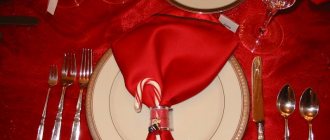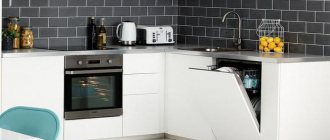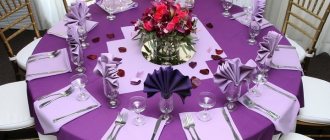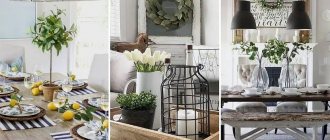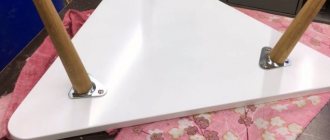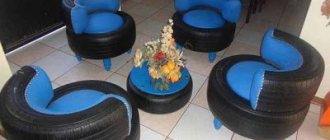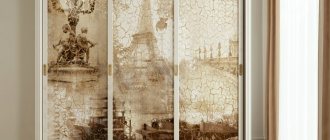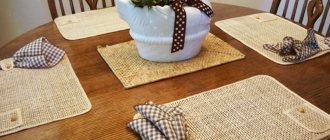/Accessories and decor/Decoration/
Proper serving is always a sign of attention to guests, a way to create a festive atmosphere, and also an indicator of the artistic taste of the hostess.
- In this material we will look at the rules of informal serving, that is, those that are appropriate for receiving guests at home in everyday life and on holidays.
- Serving at home depends on the occasion, time of day, theme and menu, but in all cases the purpose of serving is the same - to arrange the dishes and cutlery so that it is convenient and pleasant for the diners to eat.
Based on this goal, table setting rules were invented. In everyday life, all these canons need to be observed only on the most solemn occasions, but once you have mastered their essence, you will be able to set the table with your own hands for any occasion - from a romantic dinner to a family New Year celebration.
Before you begin, take a look at two sample table settings. As you can see, setting a home holiday table for guests is much easier than setting a formal reception!
So, how to set the table? We have compiled step-by-step instructions in a certain sequence, describing each of the stages. In short, the most convenient procedure is as follows:
- Tablecloth – Plates – Cutlery – Glasses – Napkins – Decor (vase with flowers, candles, themed decorations).
Keep in mind that a few days before the event you need to resolve all organizational issues and prepare:
- Decide on the number of people, create a menu, tidy up the tablecloth, check the quantity and quality of napkins, dishes, cutlery, and think about the decor.
On the day of receiving guests, wipe all dishes and cutlery clean, and then start setting the table.
And a little about the arrangement of dishes
In addition to serving cutlery and dishes, you need to lay out the food dishes themselves. Here is a small reminder on how this can be done beautifully and correctly.
OK it's all over Now. We wish you successful practice and happy, heartfelt holidays!
Support the project - share the material with your friends on social networks:
Sequence of table setting
The table should be set according to the following plan: tablecloth; dishes; cutlery; glasses, wine glasses, glasses; napkins; table decoration. To begin with, table setting may seem like a really complicated science to some, but after some time, when setting the table according to the rules becomes a habit, it will seem to you that this task is easier than ever!
The tablecloth must be perfectly ironed and have a presentable appearance. There is nothing good about setting the table with a crumpled tablecloth or oilcloth. The smoothed tablecloth, or rather its corners, should fall opposite the table legs, covering them evenly.
Etiquette secrets from aristocrats
When you find yourself in a gourmet restaurant or at an event where many respected people are present, you want to make a good impression and present yourself in the best light. To do this, you should know a few secrets that will help you behave correctly at the table:
- Sit at the table correctly, with a straight back, facing the table. After sitting down, there should be a distance equal to the width of your palm between you and the table.
- Use the napkin correctly. Fold a large rectangular napkin crosswise so that one end is twice as long as the other and place it on your knees with the fold in front. This will keep your clothes covered and also allow you to dry your mouth and hands.
- To prevent lipstick from leaving marks on the glasses, first remove it from your lips. If you don't want to remove the lipstick, discreetly lick the edge of the glass before drinking, creating an additional "barrier" for the lipstick.
- Under no circumstances should you bite baked goods. Carefully break off a small piece directly on the pie plate, holding the piece with your other hand. To spread butter on bread, you need to use a special knife. At the same time, take the required amount of product and place it on a pie plate, and only from there spread it on the bread.
- Oddly enough, according to the rules of etiquette, it is not advisable to wish other guests “bon appetit.” This applies to those cases when you are going to a restaurant or cafe. According to etiquette standards, only the chef can express wishes for a bon appetit.
- According to the rules of good manners, salad should only be eaten with a fork without using a knife, which can only be used as a last resort when you need to hold onto a piece of food. Under no circumstances should you cut the salad in a plate.
- Elbows should be pressed to the body. Never place them on a table, and also watch your posture.
- When eating soup, hold the spoon not sideways, but with the sharp end towards your mouth.
- When drinking tea, hold the cup not in the usual way, by sticking your finger into the hole, but holding it by the handle with your thumb and forefinger.
- Try not to come to the event hungry. This will keep you from grabbing everything and will make you look good.
Table setting is divided into several types depending on the nature of the event, as well as several styles, in accordance with the surrounding interior. By following simple tips and recommendations, you can set the table without much difficulty and appear before your guests as an attentive and hospitable hostess.
What kind of plate can be put in the microwave?
It is convenient to heat food in plates, but this can only be done if the material is microwave compatible. The best way to find out about compatibility is to review the information provided by the manufacturer.
What does the marking :
- Microwave safe - suitable for heating and cooking / But if this phrase is crossed out, then the manufacturer reports that the plate is incompatible with microwave ovens.
- Not recommended microwave - not recommended.
- Plastic marked PP is not suitable for hot food and is intended exclusively for storage at room temperature and in the refrigerator.
The following dishes should not be placed in the microwave oven:
- made of metals;
- with decoration using dyes containing metals (gilding, silvering);
- crystal;
- some types of porcelain and ceramics (intended exclusively for serving).
Suitable for microwave:
- heat-resistant and tempered glass;
- glass porcelain and glass ceramics;
- heat-resistant porcelain and ceramics for ovens;
- Microwave compatible plastic;
- silicone
Popular earthenware plates can be heated in the microwave, but for long-term cooking it is better not to use them, since the porous mass is prone to cracking.
How to hold a spoon correctly
The spoon should lie on the hand with its convex side facing the table, the handle in place between the index and thumb, its thinnest part at the very end of the index phalanx, held with the tip of the thumb.
It is preferable to constantly give it a horizontal position, not allowing the elbows to participate in the process, only the hands.
Arranging cutlery
Cutlery should be 10mm apart from each other and the plate.
• The fork is on the left and the knife is on the right, as is the spoon. • The fork should be with its teeth up and the knife with the blade facing the plate. • If there are more than three dishes on the menu, then you do not need to lay out all the cutlery; they should be taken out when needed. • With the plate there should be a fork and a knife, after them for fish, then a knife and fork for various salads. • A spoon can be placed instead of a fish fork.
The main points of decorating holiday table dishes with your own hands
Before you use beautiful cuts for decoration, solve organizational issues. Prepare dishes, necessary materials, and napkins in advance. Also, be sure to consider a few key points.
- You should not spend a lot of money on purchasing dishes of the same color. Modern design involves the arrangement of devices in bright flashy colors.
- As for glassware, it is better to choose the same models. The design of the table will be ugly if you use glasses or glasses of different styles. Timeless classics are welcome: transparent options.
- Any table setting should be in the same style. Let it be shabby chic or modern. It is better to refuse combinations of two different directions in the design of the festive table.
- To emphasize the coziness in the kitchen, you need to use a simple home tablecloth with a checkered motif. Moreover, even the smallest cell will look interesting, especially on a square table.
- Don't forget about the play of shapes and materials. Use different coasters for each person. These can be straw napkins, bamboo rectangular mats, thin cutting boards, or woven fabric bedding.
- Choose textile napkins only in shades that are lighter than the main color scheme of the table decoration. As for the material, it is better if it is cotton or linen options.
Slicing seafood on the festive table Source blog.comfy.ua
Beautiful table decoration with interesting snack options Source ne-kurim.ru
Original sausage product on the festive table Source amic.ru
Festive serving of salad for the New Year's table Source cookpad.com
Decorating the table with fruit in the shape of a three-dimensional Christmas tree Source eda.show
On a note! To emphasize the richness of the table, be sure to place jars of spices, a salt shaker and a container of vinegar in the center.
For a birthday
A birthday is considered an important holiday, so it is necessary that the table setting corresponds to this celebration; you need to work smartly on the design. The main thing is not only to arrange the dishes beautifully, but also to do everything possible to ensure that the decor matches the season.
Interesting table design for a girl’s birthday Source truck-sodruzhestvo.rf
For example, in the fall you can put the gifts of nature on the table: fruits and vegetables. For this it is better to use a special vase or basket. In winter, it is better to use tablecloths and other textiles in snow-white or heavenly colors. The table service can have different thematic decor: painted snowflakes, monograms, interesting shapes.
Large table in red colors for a child’s birthday Source mblx.ru
If an anniversary or birthday takes place in the spring, then the table should be decorated with fresh flowers and various compositions of them to choose from. Don't clutter up the entire space. It is enough to place two narrow long vases made of transparent glass, and place them in the center of the table if it is round or near each narrow side if it is rectangular.
Festive table with luxurious table settings for a birthday with personalized places Source roomester.ru
What materials are plates made from and what to choose?
Different materials are used to produce plates. When choosing, be guided by the purpose and operating conditions of the cookware. Be sure to consider microwave compatibility and dishwasher safety if applicable. For everyday use you need practical cookware. For special occasions, you can choose a more beautiful and festive one.
Porcelain, faience, ceramics
All these materials are based on clay. The difference between them is in the firing method and modifying additives.
- Ceramics is a mixture of clays with mineral additives, which must be fired and covered with glaze. The tableware is thick and massive and retains heat for a long time.
- Faience is a cheap porous material, products from which are coated with a low-melting glaze and fired once. Glaze makes surfaces bright and beautiful, but tends to chip. Earthenware plates are fragile, although not thin, they split from blows and break.
- Porcelain plates are light and thin, but durable due to the absence of pores. The most expensive bone china , to which bone powder is added for strength and improved appearance. Real porcelain allows light to pass through. Professionals recognize it by the characteristic sound when tapped.
- Semi-porcelain differs from porcelain in the firing technology - it is not fired until completely sintered. The products are not as durable as porcelain, but stronger and more beautiful than earthenware due to less porosity.
Real high-quality porcelain shines through in a thin layer and is white with a slightly bluish tint. Ceramics and earthenware do not allow light to pass through and make dull sounds when tapped.
When choosing, consider not only the material, but also the type of decoration. Gilding looks impressive, but such dishes are not suitable for everyday use - they cannot be put in the microwave, and the paint from hot water and detergents loses its shine and wears off. The most durable underglaze painting is applied before glazing and baking.
Glass of different types
We have already talked in detail about what types of glass plates are made from and which is the most practical and convenient on our website “Types of Tableware”. Let's take a brief look here.
For the manufacture of high-quality glassware, sodium-lime, sodium-lime-potassium, lead, zinc-barite and borosilicate glass are used. But often, instead of technical names, manufacturers use names that are more understandable to the consumer.
Modern glass plates are transparent and made of a dense mass. Utensils for every day are made from tempered glass , which is not afraid of frost and high temperatures, and is suitable for microwaves.
If the manufacturer indicated impact-resistant glass in the manufacturing material, this indicates that the composition contains polymers that enhance strength and prevent sharp fragments when cracked.
Opal glass is obtained by adding spar, dolomite and bone ash; it is very thin, but durable and practical. Opal tableware is translucent, matte, and beautifully reflects light, reminiscent of the stone for which it is named.
Glass porcelain and glass ceramics
Modern materials obtained by crystallization of multicomponent glass in the presence of fluorides. In appearance they resemble thin and elegant porcelain or thicker and more massive ceramics. The materials are similar in composition and manufacturing method, but different manufacturers develop their own technologies, achieving slight differences.
Glass porcelain and glass ceramics are practical, impact-resistant, resistant to temperature changes, microwave and dishwasher compatible, and scratch resistant. The surface is smooth, does not absorb juices and does not stain. A big plus is that there is no glaze, nothing to chip off.
Tree
Wooden plates attract lovers of eco-style; they are made from both natural wood and pressed wood with the addition of substances that increase resistance to moisture. The tree is suitable for serving bread, pizza, buns, other dough products, and cheese. Oily and moist products will leave marks and odors if the wood has not been properly treated.
Wooden dishes and plates are made from ash, oak, cedar, ash, and bamboo. To increase resistance to moisture, wood is impregnated with vegetable oils. This also includes serving boards - a stylish alternative to plates.
Metals
Metal plates are available in stainless steel and sheet aluminum. First of all, such dishes are intended for hiking and are often located in sections for tourists in online stores. It also makes sense to consider metal cutlery for small children and the elderly - it is safe even if it falls on a tiled floor.
The downside is that it is not suitable for microwaves, and the appearance is not for everyone. The metal walls heat up from the food, while the contents quickly cool down.
Plastic
Only reusable food grade plastic is suitable for the production of tableware. Look for the markings: PP (PP) and 2 (HDPE). When studying the characteristics, it is first of all important to look at the minimum and maximum operating temperatures and make sure that it can be used for storing food in the refrigerator and heating food in the microwave.
Plastic dinnerware is not very popular when it comes to the home. Rather, it is suitable for camping conditions, trips to nature, and in the country. When choosing, it is recommended to give preference to high-quality dense plastic.

